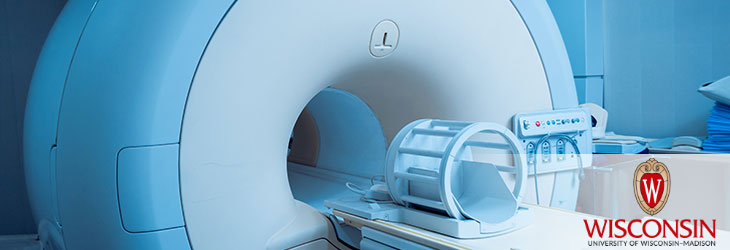Radiation Therapy

Multi-Beamlet Resolution Proton Therapy (MBRPT) for Ion Beam Treatment of Tumors
WARF: P07287US
Inventors: Thomas (Rock) Mackie, Ryan Flynn
The Wisconsin Alumni Research Foundation (WARF) is seeking commercial partners interested in developing an external radiation therapy system that uses multiple ion beam spot sizes to yield a precise trade-off between tumor treatment speed and accuracy.
Overview
External beam radiation therapy is a tumor treatment technique that directs one or more high-energy radiation beams to the tumor. External beam radiation systems treat tumors with multiple X-ray fan beams that can be rotated around the patient. Each beam consists of individual “beamlets” that can be controlled to treat complex tumor shapes. An alternate beam radiation therapy technique involves the use of ions, such as protons, to treat tumors. This technique dramatically reduces the radiation dose to healthy tissue when compared with X-ray radiation therapy using photons.
The dose intensity from protons is not uniform along the beam path and rises to a “Bragg peak” near a point where the proton beam stops completely. Controlling the placement of the Bragg peak so it is located on the tumor reduces the amount of radiation delivered to the patient’s healthy tissue. Unlike X-ray radiation therapy, ions allow for separate control of the total dose of radiation (intensity) and distance the Bragg peak occurs (range).
Existing proton therapy techniques utilize different beam application methods. The spread out Bragg peak (SOBP) approach spreads the ion beam out into an “area beam” to cover the entire tumor in one exposure. This method is fast, but is less precise and requires a special compensator to adjust for the tumor shape. The magnetic spot scanning (MSS) approach uses the original ion “pencil beam,” but due to the multiple exposures the process is slow and results in missed “cold spots.”
The dose intensity from protons is not uniform along the beam path and rises to a “Bragg peak” near a point where the proton beam stops completely. Controlling the placement of the Bragg peak so it is located on the tumor reduces the amount of radiation delivered to the patient’s healthy tissue. Unlike X-ray radiation therapy, ions allow for separate control of the total dose of radiation (intensity) and distance the Bragg peak occurs (range).
Existing proton therapy techniques utilize different beam application methods. The spread out Bragg peak (SOBP) approach spreads the ion beam out into an “area beam” to cover the entire tumor in one exposure. This method is fast, but is less precise and requires a special compensator to adjust for the tumor shape. The magnetic spot scanning (MSS) approach uses the original ion “pencil beam,” but due to the multiple exposures the process is slow and results in missed “cold spots.”
The Invention
UW–Madison researchers have developed an external radiation therapy system that uses multiple ion beam spot sizes to yield a precise trade-off between tumor treatment speed and accuracy. The system uses larger area beams for large, homogeneous portions of the tumor and then smaller pencil beams for edge delineation and small dose areas. This combination eliminates cold spots altogether.
The system consists of an ion source that produces an ion beam that is steered around the tumor area. The beam’s width and range is determined by a beam controller that executes stored radiation plans for treatment. Different beam widths are applied to different areas to give a flexible trade-off between accuracy and speed. In addition, the ability to control the beam size reduces neutron contamination to the patient. The beam width may be varied by means of quadrupole magnets, scattering foils or a dielectric wall accelerator.
The system consists of an ion source that produces an ion beam that is steered around the tumor area. The beam’s width and range is determined by a beam controller that executes stored radiation plans for treatment. Different beam widths are applied to different areas to give a flexible trade-off between accuracy and speed. In addition, the ability to control the beam size reduces neutron contamination to the patient. The beam width may be varied by means of quadrupole magnets, scattering foils or a dielectric wall accelerator.
Applications
- External ion beam radiation therapy for the treatment of tumors
Key Benefits
- Provides an improved trade-off between accuracy and speed
- Reduces neutron contamination
- Eliminates cold spots
- Reduces treatment time
- Increases treatment accuracy
Tech Fields
For current licensing status, please contact Jeanine Burmania at [javascript protected email address] or 608-960-9846